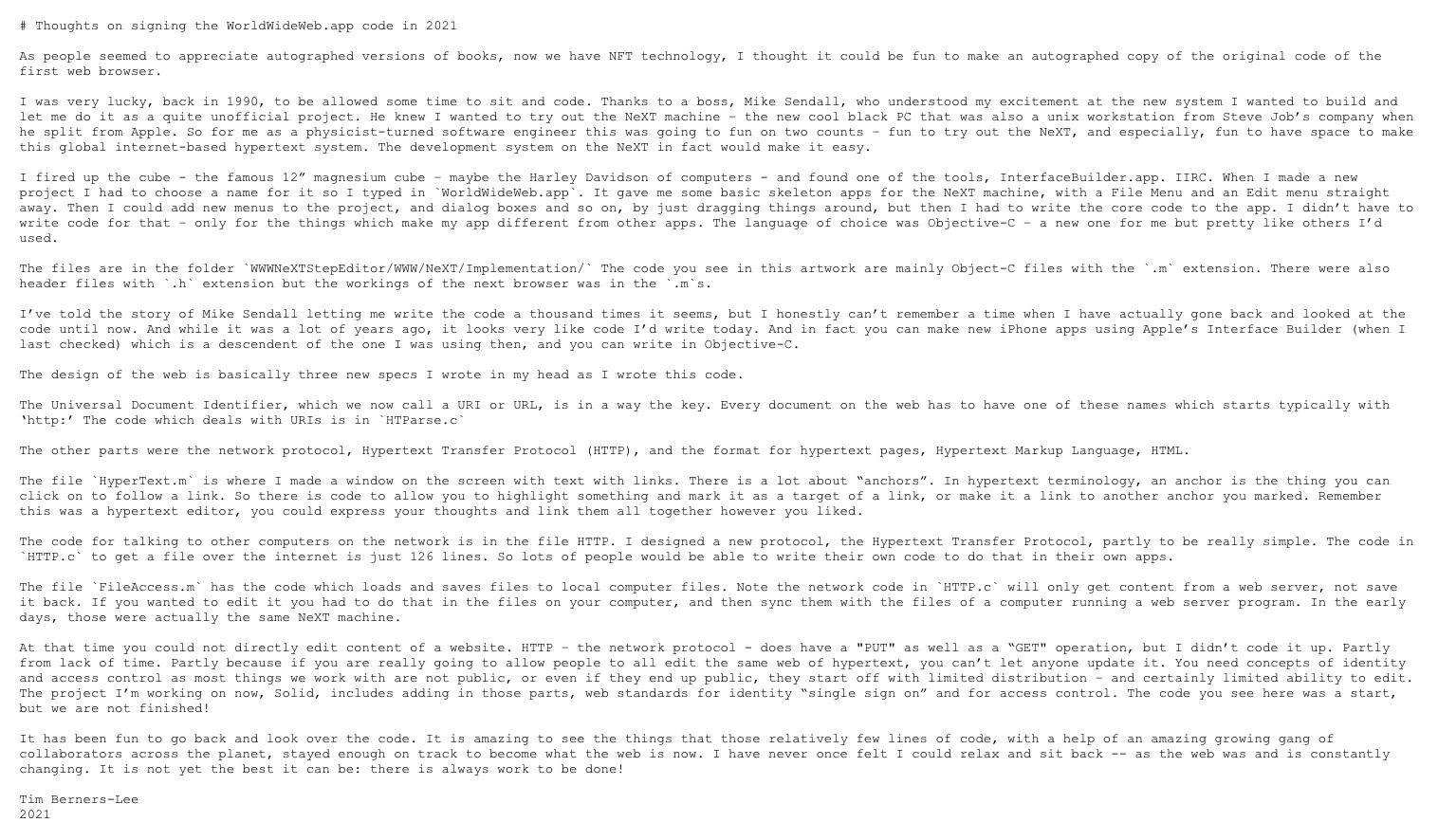
Next week, Sir Tim Berners-Lee will auction an NFT of the original source code he used to create the World Wide Web.
The centerpiece of the digital collectible will be 9,555 lines of time-stamped source code split among files created by Berners-Lee between October 3, 1990, and August 24, 1991. That code, mostly written in Objective-C, served as the early foundation for much of the modern Internet, including this very site. The files cover implementations of HTML, HTTP, and URIs, along with the original HTML documents that Berners-Lee wrote as a sort of “read me” for the early web.
The NFT will also include a letter recently written by Berners-Lee containing his musings on the original Web code. The letter is written in Markdown, making it Github-ready. The NFT will also come with an animated 30-minute black-and-white visualization of the code being written. Lastly, the lucky winner will receive an SVG “poster” of Berners-Lee’s code, which the man himself made using a Python script. The poster also includes his vectorized signature in the lower right.
 Tim Berners-Lee wrote a letter with thoughts on the World Wide Web and the process by which he invented it. It's included in the NFT as a README.md file.Courtesy Sotheby's
Tim Berners-Lee wrote a letter with thoughts on the World Wide Web and the process by which he invented it. It's included in the NFT as a README.md file.Courtesy Sotheby's Berners-Lee reflecting on the creation of the World Wide Web.Courtesy Sotheby's
Berners-Lee reflecting on the creation of the World Wide Web.Courtesy Sotheby's Berners-Lee also created an SVG "autographed" poster of code.Courtesy Sotheby's
Berners-Lee also created an SVG "autographed" poster of code.Courtesy Sotheby's
NFTs, short for non-fungible tokens, are essentially digital certificates of authenticity. They’ve sprung up as a way for collectors to assert ownership over “original” digital assets that are, apart from the token, indistinguishable from any other digital copy. Berners-Lee’s World Wide Web NFT is encoded as a contract on the Ethereum blockchain.
Even today, you can still download some of the original code for free through various sites, including at W3C and CERN. The files in the NFT are “similar” to those in the CERN link, “however the CERN code is a slightly later release,” said Sotheby's spokesperson Melica Khansari. “The NFT is a unique package put together by Sir Tim.”In selling an NFT of the original code, Berners-Lee appears to be having his cake and eating it, too, just some 30 years later. When CERN released Berners-Lee's WorldWideWeb code in 1993—the name didn’t have spaces back then—it was unencumbered by patents or royalty demands. Next week’s NFT, then, is Berners-Lee’s chance to cash in on the original code, though this NFT appears to be for charity. “The sale will benefit initiatives that Sir Tim and Lady Berners-Lee support,” Sotheby’s said in a statement. Bidding will start at $1,000.
Berners-Lee invented the World Wide Web at CERN in 1989 when he proposed a “distributed hypertext system” inspired by the challenge of managing the influx of data that the Large Hadron Collider was all but certain to produce. “Many of the discussions of the future at CERN and the LHC era end with the question ‘Yes, but how will we ever keep track of such a large project?’” Berners-Lee wrote in the proposal.
In response to the proposal, Berners-Lee’s boss handed him a shiny new NeXTcube so he could implement his ideas in code. The result was the WorldWideWeb application, a WYSIWYG tool that combined browsing and HTML authoring. It saved files to the local disk to be served up by httpd. Today, you can explore Berners-Lee’s original ideas on CERN’s website, where the world’s first website has been posted, along with a virtualized version of the first browser that runs within your far more modern equivalent. Article From & Read More ( Tim Berners-Lee makes an NFT from World Wide Web’s Objective-C - Ars Technica )https://ift.tt/3zsM2N2
Technology
Bagikan Berita Ini














0 Response to "Tim Berners-Lee makes an NFT from World Wide Web’s Objective-C - Ars Technica"
Post a Comment